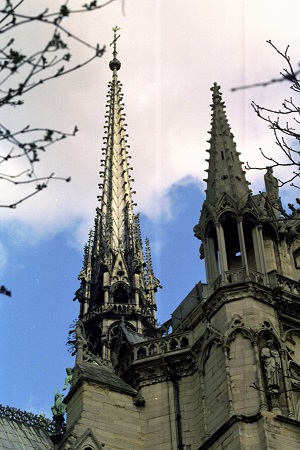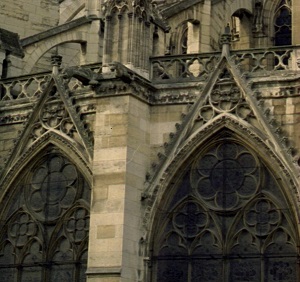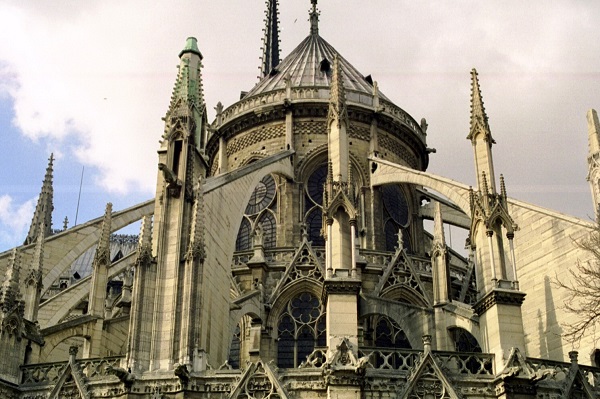31 Aug Building a Cathedral of Knowledge
 Good fiction, especially good historical fiction, gets my brain spinning. Ken Follett‘s The Pillars of the Earth and World Without End describe the technology, born in the “Dark Ages” in which mortal men were able, with limited technologies, to build edifices that could stand throughout the ages. At the same time as Mr. Follett’s mythical cathedral was being raised to the heavens, Notre Dame de Paris, subject of many of my own photos was rising across the channel and down the river. It took incredible genius to build these cathedrals, and many, many hewn stones.
Good fiction, especially good historical fiction, gets my brain spinning. Ken Follett‘s The Pillars of the Earth and World Without End describe the technology, born in the “Dark Ages” in which mortal men were able, with limited technologies, to build edifices that could stand throughout the ages. At the same time as Mr. Follett’s mythical cathedral was being raised to the heavens, Notre Dame de Paris, subject of many of my own photos was rising across the channel and down the river. It took incredible genius to build these cathedrals, and many, many hewn stones.
I like Follett’s fictionalized accounts of the range of challenges these innovators faced, because they ring true. I have encountered many challenges in building knowledge systems, and like the architects and builders of old, been forced to solve unexpected problems, come up with new paradigms, and work against a tide of nay-sayers. I also like the comparison between the process of building a cathedral and building a knowledge base that will bear the load. It became obvious to me, as a young computational linguistics visionary, that the practitioners of the day were missing a very important point: to build a system that can understand language well enough to translate it accurately, the system would have to “know” as much as the speakers of the language about the real world. Back in the mid-1980s, when I came to that conclusion, this was unusual thinking.
| Understanding Context Cross-Reference |
|---|
| Click on these Links to other posts and glossary/bibliography references |
|
|
|
| Prior Post | Next Post |
| Eclecticism and Cognitive Modeling | Brain Form and Function |
| Definitions | References |
| knowledge base paradigm | The Pillars of the Earth |
| understand natural language | World Without End |
| metaphor | Sir Francis Bacon The New Organon Analysis |
 In the 1990s, I took my first trip to Paris and saw the great cathedral on Île de la Cité surrounded by the Seine. It captured my imagination, and my wife, Ann, was very patient as I kept circling the building, changing lenses and shooting from any angle that caught my eye. The design of the windows, arched “cathedral” style, is necessary to permit such large open spaces to support the weight of stone above. The buttresses, both standard and “flying” are needed to permit the walls to rise to impossible heights (without a welded steel superstructure) and keep the stresses from knocking them down. Here’s the simile behind the metaphor:
In the 1990s, I took my first trip to Paris and saw the great cathedral on Île de la Cité surrounded by the Seine. It captured my imagination, and my wife, Ann, was very patient as I kept circling the building, changing lenses and shooting from any angle that caught my eye. The design of the windows, arched “cathedral” style, is necessary to permit such large open spaces to support the weight of stone above. The buttresses, both standard and “flying” are needed to permit the walls to rise to impossible heights (without a welded steel superstructure) and keep the stresses from knocking them down. Here’s the simile behind the metaphor:
The Knowledge Base design has a foundation, binding and buttresses.
- The foundation of the cathedral is context.
- Context is perceived through the senses and inextricably bound to time and place
- The binding mortar is the associations between knowledge objects.
- Built through a lifetime of remembered experiences, associated in context, cured with repetition
- The buttresses are the statisticalprobabilitities of the associations between knowledge objects, selectively strengthening the areas that most need reinforcement.
- Reasoned out in our minds, the likelihoods and unlikelihoods of what comes next keep us a step ahead of complete confusion
The bricks of the cathedral, each independent knowledge object, are built on the foundation of context, bound together by the mortar of their associations and buttressed by the strength of their likelihoods within each context. This is my idea of a reliable architecture for knowledge.
 We “know” about the cathedral because we can touch it, shelter inside it, and hear the echoes of our voices bouncing about the walls. Yet throughout the centuries, really intelligent philosophers have questioned the possibility of knowledge. “Can we truly know anything?” Maybe not, but I think we need a knowledge base anyway.
We “know” about the cathedral because we can touch it, shelter inside it, and hear the echoes of our voices bouncing about the walls. Yet throughout the centuries, really intelligent philosophers have questioned the possibility of knowledge. “Can we truly know anything?” Maybe not, but I think we need a knowledge base anyway.
Sir Francis Bacon, in his preface to The New Organon, suggests that empirical development and proof of knowledge is satisfactory. His is a pragmatic approach. We need not argue about the knowability of a thing. All we have to do is demonstrate that we have “done enough” to build the foundation, binding and buttresses of knowledge to demonstrate that it is usefully constructed. Useful includes, of course, the ability to construct functions that efficiently leverage the knowledge, as well as learning and maintenance procedures that can be automated. This automation is needed because of the huge amount of knowledge implied by my earlier statement: “the system would have to “know” as much as the speakers of the language about the real world.” I presume that it will be necessary to mine and leverage knowledge that already exists in digital form, whether it is on the World Wide Web, in ontologies or other structured sources that will shortcut the process. Doing enough to ensure the structure can be built and can withstand the test of time is my whole goal in this effort.
| Click below to look in each Understanding Context section |
|---|








